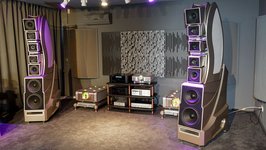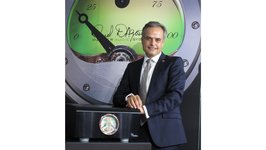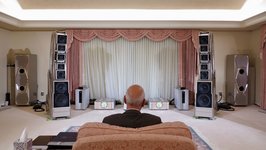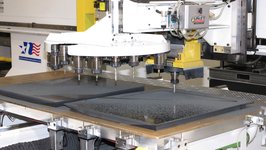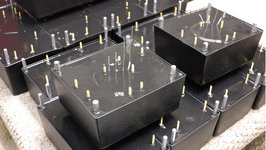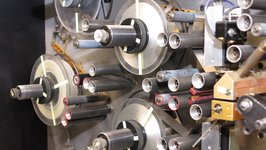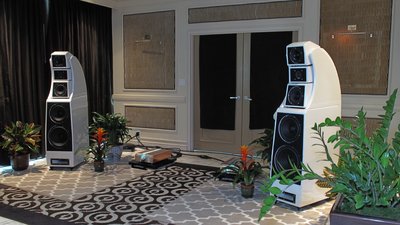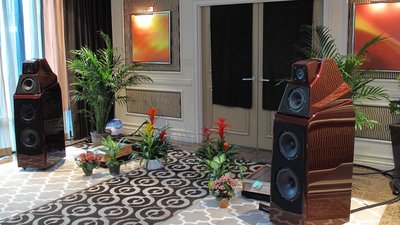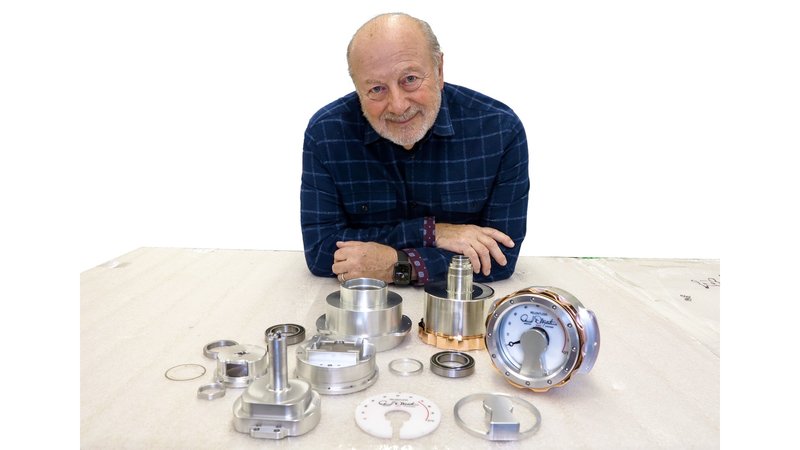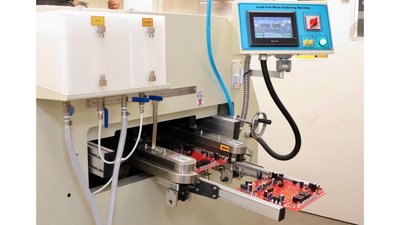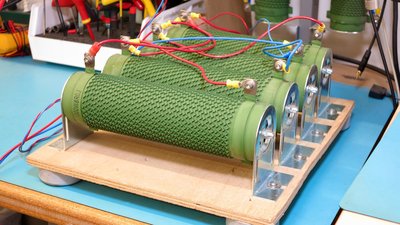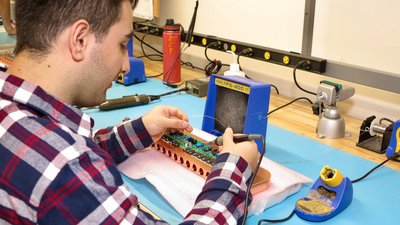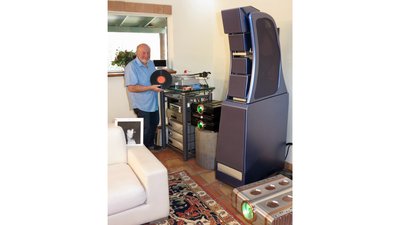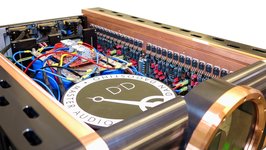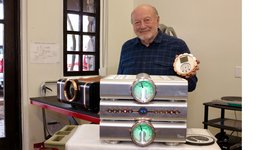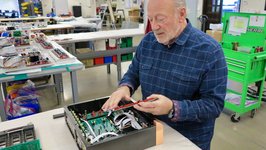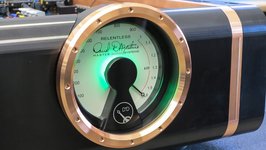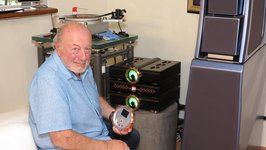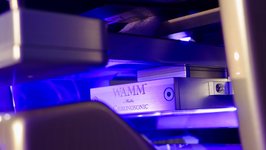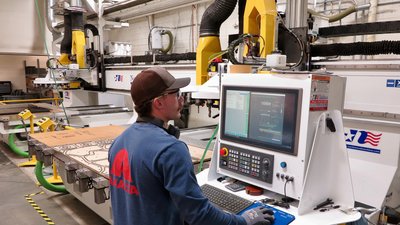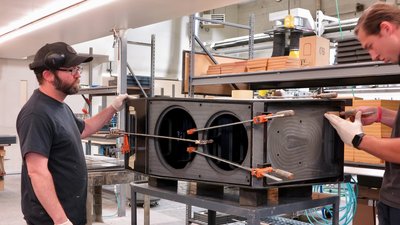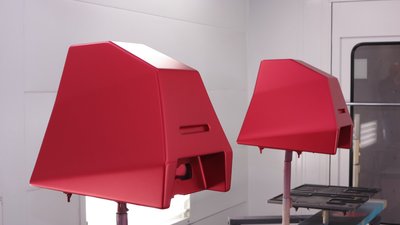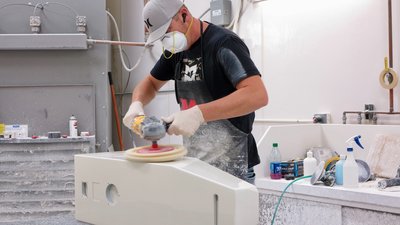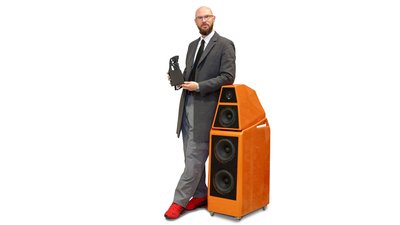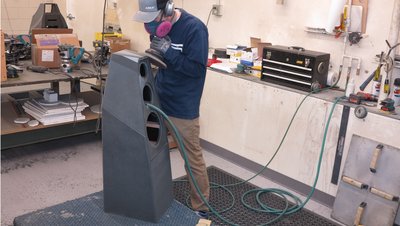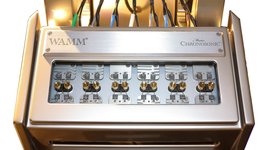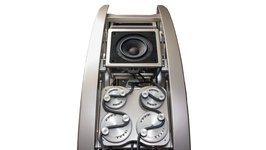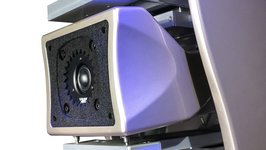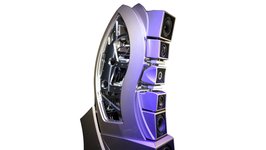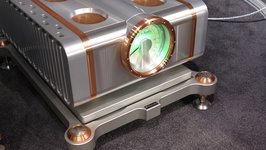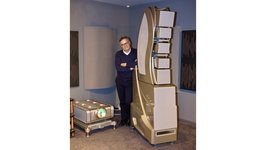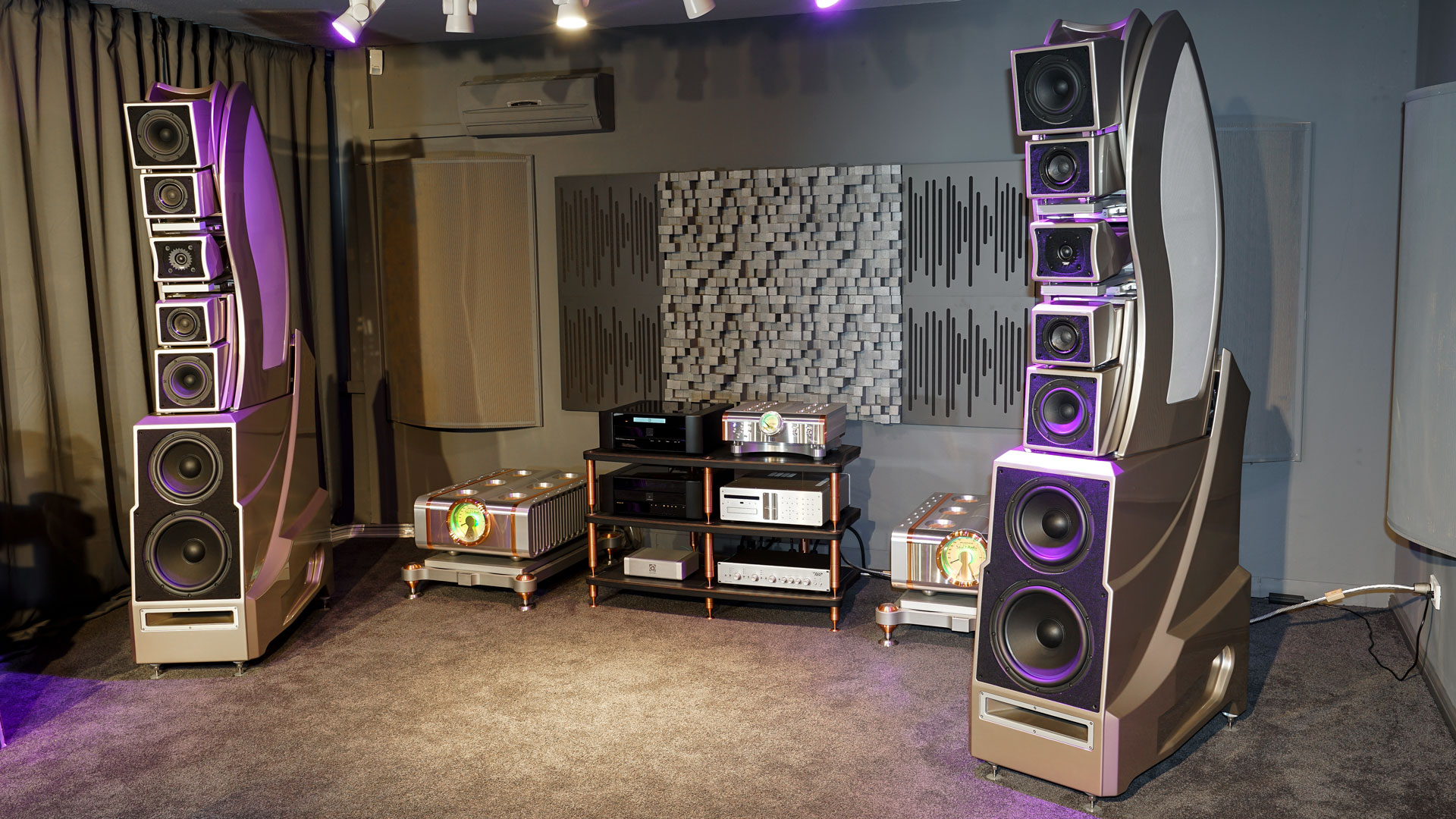
Report
STEREO visits Wilson Audio and Dan D᾽Agostino
High-End Mega-Trip – What an experience! In the Audio Reference showroom in Hamburg, Germany, we went on a trip to the limits of the high-end universe with an ultimate system consisting of components from Dan D‘Agostino and Wilson Audio. As if that wasn‘t enough, we traveled to the US and searched for the secrets of both manufacturers at their headquarters.
"A trip around the hi-fi world with my pockets full of money," I softly hum, adapting an old German hit song; and filled with anticipation for the upcoming appointment. For now, I‘m only going to Hamburg to visit the high-end distributor Audio Reference, which represents multiple exclusive brands in Germany. In their acoustically almost perfect showroom, an ultimate system is awaiting us.
Welcome to the realm of high-fidelity superlatives! Size, weight, price as well as sound quality – even the already wide limits of the audiophile high society are not only tested, but easily broken here. We are honored by the presence of: the mono power amplifier and speaker majesties D‘Agostino Relentless Epic 1600 – for which the rack manufacturer Bassocontinuo created heavy metal thrones with a fitting finish – as well as the 2.24 meter high Wamm Master Chronosonic, the flagship model of the highly renowned American speaker manufacturer Wilson Audio.
What we can anticipate is nothing but an exceptional high-end experience as well as the culmination of a long series of extraordinary encounters with the components of these two manufacturers. Over the years, I have reviewed a number of Wilson speakers designed and built in Provo, Utah. The by now replaced Maxx3 (see German STEREO issue 12/09), for example, remains unforgettable. In combination with the equally powerful and sophisticated Soulution electronics, they were possibly the best thing that ever performed in our listening rooms.
Unforgettable Impressions
I could extend the list of such almost supernatural encounters of the third kind virtually indefinitely. Another example would be in 2016 and 2017 at the CES in Las Vegas. In a spacious suite of the Venetian Hotel, which hosted the "Audio Exhibition", first the Alexia was set up and the following year the Alexx, new at the time. Dan D‘Agostino‘s Momentum monos always took over the power amplification, while the so-called front end, i.e. source devices and preamplifier, came from the British specialist DCS. They were the "Best Sound of the Show" for me both times. The performances were outstanding in every respect: lively, breathing, completely detached from the multi-piece speaker cabinets, with sophisticated fine dynamics and impressively shaped in terms of depth topography. To put it plainly: it was pure music without any technoid touch. You rarely hear anything like that. My fifteen minutes in the sweet spot in front of the Alexx with Brian Wilson‘s ingenious and sonically outstanding album "Smile" has become forever ingrained in my memory as an all-time highlight.
Best Sound of the Show? Wilson Audio‘s Alexia (r.) and Alexx (l.) delivered amazing sound with D‘Agostino‘s smaller „Momentum“ monos at CES in Las Vegas in 2016 and 17.
Testing the Boundaries
Well, and now we meet the huge Wamm Master Chronosonic on the hardly less impressive Relentless mono power amps from veteran Dan D‘Agostino. He was already notorious for his extreme power amplifiers while at Krell. Even the raw numbers of the mega-stereo are shocking: The pair of Relentless Epic 1600s weighs in at around 700 kilograms. The Wilsons even reach a whopping 820 kilos. The prices come in at a remarkable 350,000 respectively – brace yourselves! – 850,000 euros.
Go Hard or Go home!
Considering how hard Dan D‘Agostino goes on substance, his expertise easily fades into the background.
Everything is bigger in America: the SUVs, the steaks, and even the amps, as Dan D‘Agostino‘s massive Relentless Epic 1600 monos prove. The company that stands behind them – located a 30 minute drive outside Phoenix, Arizona in Cave Creek, and housed in the local hacienda style –, is rather well-organized and dignified. With full focus, the employees sit at tables and solder parts into circuit boards, for example. For our visit, the team put some components on display to explain their work. One thing in particular attracts our attention: the imposing level meter of the new Relentless preamplifier, which is presented both finished and disassembled. There it is again, the gigantomania that characterizes many of Dan D‘Agostino‘s projects.
It‘s always been like that. Even though his current company has only been around for 13 years, the man is a developer icon and living legend. An aficionado of fast cars, he founded Krell Industries in 1980 and soon fascinated the hi-fi world with massive power amplifiers, which became his trademark. After selling Krell in 2009, he really went full throttle with "Dan D‘Agostino Master Audio", as the full name goes.
»Super Rail«-Power
The true meaning of that is made clear not only by the complexity of the huge, green illuminated level meter. The copper profiles supplied by a special company for the large mono amps Relentless Epic 1600 – a smaller version, the Epic 800, will be released soon – weigh around 40 kilograms each. The 112 power transistors are mounted on two of them. D‘Agostino cites the material‘s unparalleled thermal conductivity as the reason for using so much of it. In addition, the entire surface is thus supposed to be at the same temperature, which he says is incredibly important in view of the sheer number of semiconductors, in order to ensure identical operating points for all of them. The copper planks then dissipate the heat into the outer aluminum heat sinks.
D‘Agostino, to whom a tremendous amount of inventions and innovations can be attributed, is aware of the importance of such semingly minor details. In the 1600 mono amps, recently enhanced via the "Epic" upgrade, his "Super Rail" is used, in which a high-voltage design before the output stage virtually "charges" it like a turbo would a cylinder bank. Therefore, the amp is said to never run out of steam, even at maximum load.
The production department wants to ensure that everything works stable and correct under such extreme conditions by exercising the appropriate attention to detail. That‘s why the Americans have been working with their own computer-controlled soldering unit for some time now. Simply enter the specific board type in the touch display, and the machine pulls the boards carrying the loosely inserted parts into its interior. Shortly afterwards, they come out again on the other side, assembled with the utmost precision.
The Relentless Epic 1600 Deserves Its Name
At the measuring station, D‘Agostino proves that the output power specified for the Epic 1600 is not an empty promise, letting its level meter shoot up to its limit. The meter reports 1,590 watts into eight ohms, and the resistors, which can be loaded with up to four kilowatts, start to smell. On a 220-volt grid, the power would easily double at four ohms and quadruple at two ohms. The measuring resistors beg for mercy.
In Dan‘s home, it‘s less about raw power and more about impressive sound images. Here, Wilson Audio‘s Chronosonic XVX play with prototypes of the Epic 800 plus the new Relentless Pre. These amps also have an easy time with the giants one step below Wilson‘s top-of-the-line model. As expected, it sounds absolutely superb, though not quite as drastically to the point as in Provo, rather tuned for living rooms. And everyone is happy.
But there is one thing that troubles the "grand master of high-end electronics": What should he introduce after the Relentless Epic 1600? Even more elaborate and potent mono power amps? That would no longer fit into D‘Agostino‘s vision, but so far he has always surpassed himself.
In view of such enormous sums, the costs for D‘Agostino‘s equally extreme Momentum preamp and the top source devices from Meridian or Krell hardly matter anymore. The bill for the complete Nordost cabling, which conducts all signals and is responsible for the power supply, isn‘t small either. Well, gotta go the whole way...
And the visual impression is quite fitting. It‘s almost like sitting in front of a mountain range: the D‘Agostinos‘ generous round level meters shine like greenishly sparkling lakes in a valley between towering speaker mountains on either side, their fronts as fractured as a rocky mountaintop. This is due to the individually suspended modules of the drivers for the middle and high frequencies. Wilson Audio did not choose the name "Chronosonic" for arbitrary reasons. It alludes to the extreme temporal accuracy of their music reproduction.
The American company was among the first to focus on this aspect of loudspeaker design, which is now considered a crucial aspect. Other manufacturers sometimes place their tweeters somewhat recessed into the baffle, in order to mechanically compensate for their speed compared to the slower woofer cones. But Wilson pushes the issue to the limit.
Thus, the Sasha DAW – read our review here – and all speakers above it are equipped with movable mounts for their midrange drivers and tweeters. With those, they can be adjusted in depth and angle both in regards to each other and especially to the woofers. Of course, this is not done at random, but according to exact parameters. The distance betweeen the listening position – respectively the ear height of the listener, usually sitting on a chair or couch – and the speaker forms the reference point for the adjustments.
Time Coherence
The goal is to ensure that all signals of the first wavefront reach the listener‘s ears as simultaneously as possible. The goal is thus to avoid a blurring of fine details as well as a deterioration of spatial imaging and plasticity. Those issues stem from the phase progression not being correct, which can easily happen, especially with multi-way systems such as the enormous Wamm Master Chronosonic. In the end, the loudspeaker is focused on the listening position as precisely as a camera lens.
Worthwile Effort
At Wilson Audio, many things are different. This is exactly what makes the speakers so special.
Whoever thinks of Wilson Audio as a delicate and clean manufacturer is rather wrong. The speakers of the company, located in Provo not far from Salt Lake City, Utah, indeed look flawless and freshly peeled; but they are born amongst noise and dirt. This is primarily due to the production and finishing of their elaborate cabinets. In contrast to what is more common, these are not supplied by an external partner, but are produced in-house to the highest standards. In order to meet the demand, the Americans have recently virtually doubled their capacities.
The usual MDF boards are not used either. Instead, the manufacturer has long relied on their well-known "X-Material": highly damping as well as ultra-stable panels of varying density and thickness that consist of synthetic resins enriched with organic substances. These are combined in a complex process, which consists of a mixture of calculations and extensive listening tests. The finished cabinets then have the lowest possible tendency to vibrate with optimal energy dissipation and provide the drivers with as solid a backbone as possible. With that, not even the finest nuances are blurred out by vibrations.
But before we get to that stage, the rough plates first have to be cut to size, which is done by two computer-controlled CNC machines with extremely small tolerances. In no time at all, the milling heads rush over the hard material, already roughly forming the first edges and bevels for the faceted housings. Afterwards, these are glued together using a special adhesive and secured with collets.
The Cabinets Receive An All-Round Finish
Once the connections are secure, the real dirty work begins. In rooms with an effective ventilation system, workers – protected from dust and noise by respiratory masks and ear protectors – grind the future speakers, painstakingly and accurately modeling their typical, precisely specified shapes. If you take the entire production time of the SabrinaX, Wilson Audio‘s smallest floorstanding speaker, as an example, one worker would manage just three cabinets per week. The larger models, such as the Sasha DAW – shown below in orange – consist of several parts, which considerably increases the complexity and thus the effort required. That continues right up to the ultimate Wamm Master Chronosonic with about a dozen individually shaped parts.
Company boss Daryl Wilson sees the unique cabinet design as a key reason for the high sound quality achieved as well as the reputation that Wilson loudspeakers enjoy around the world. Daryl became head of the company after the death of his famous father and founder David Wilson in 2018. Since then, he not only realized his own projects – such as the giant Chronosonic XVX, a miniature model of which he presents here – but has also optimized many processes with regard to even higher production quality.
As an example: the crossovers are not only thoroughly engineered; since 2018, the Americans have even been manufacturing their own capacitors on top. They acquired the expertise from a trusted supplier who retired from the business and whose quality Wilson wanted to preserve. Further research led to further improvements. You can‘t see any of it, however, as the crossover components are cast firmly in their mounts after the assembly. Distortions due to microphonics, i.e. mechanical excitation mainly introduced by high-energy bass waves, should thus not be an issue. You come across more or less noticeable details that contribute to the excellent result everywhere. For example, it was discovered that lower-mass binding posts have a positive influence on the performance. Right away, the metal terminals were drilled lengthwise to save weight.
Drivers with Exact Specifications from Experts
Due to a strong relationship with proven driver manufacturers, Wilson Audio gets exactly what they want from them. "We don‘t see any need for in-house driver development and manufacturing," as Daryl Wilson explains the decision, "because our partners are excellent at that, and we‘re so deeply involved in the topic anyway, that we know what we want."
That which sounds excellent should of course also look perfect, which is why the Americans operate their own paint shop. There are several basic finishes, and virtually all RAL colors are possible for a surcharge. By the way, matte "Frozen" variants are currently rather popular. These are applied in a special way. As you might guess, the speakers are sanded and polished again and again until the result is perfect for the glossy finishes. In the end, the process is very reminiscent of a small manufacturer, where glove-covered hands wipe over tiny spots to correct barely visible imperfections.
There is no need to worry about the reliability of the quality control. Alluding to a Michelangelo quote, the devout Mormon Wilson states: "If I allow a mistake, two will see it: me and God." That would probably weigh heavily on him as well as the entire team. Thus, it‘s better to proceed uncompromisingly right away. Because it‘s worth it!
What happens when the midrange drivers and mid-woofers – which frame the tweeter in D‘Appolito, or MTM, design – are aligned with each other, guests of Audio Reference can experience during a visit. The striking loudspeakers play as precisely on the spot as perhaps only a sophisticated two-way monitor might. At the same time, however, they reproduce so broad and removed from any boundaries and, on top of that, appear so casually unaffacted at any level as only giant speakers that can effortlessly move a lot of air might be capable of.
The hands of the level meters on the super-strong power amplifiers steadily swing upwards. Two things stand out: First, hardly more than a few watts are needed even for higher volumes. And secondly, the needles sometimes move over to the right half during proper power play when strong impulses arise, such as those offered by Monty Alexander‘s "Moanin‘", signaling that the 1,000-watt mark is being approached.
Subconsciously, I compare this performance to my memories of the CES trade shows mentioned earlier. It clearly points in the same direction. However, the mega lineup in Hamburg is slightly ahead, if not in terms of precision, then in terms of power delivery and thanks to the even wider soundstage. No surprise at all, considering Wilson‘s Peter McGrath placed the loudspeakers at Audio Reference, the same expert who was in charge of the setups in Las Vegas. He just knows how get it right and achieve equally high-class results in different rooms.
In Wilson‘s »Inner Sanctum«
We could go on for ages describing and praising the exceptional abilities of this demonstration, which is probably unique in Europe, but our journey is just getting started. We want to get a first-hand impression of the manufacturers‘ skills and methods (see boxes).
Well then, off to Provo to Wilson Audio! My last visit was in early 2009. A lot has changed since then. Above all, the company has grown. For about a day, I update my knowledge of the technologies and manufacturing processes. Thus prepared, company boss Daryl Wilson opens the door to the inner sanctum late in the afternoon: his late father‘s showroom and listening room in the family estate.
During my last visit, the Alexandria XLF were placed there, on top of the Wilson speaker range back then. Now, the aforementioned Wamm Master Chronosonic have taken their place, which – unlike in Hamburg – are complemented by two "Thor‘s Hammer" subwoofers in the corners. Together with the active crossover now involved in the action, the "stunning" speaker system surpasses the magic one-million-euro price point. And here, again, D‘Agostino‘s Relentless mono power amps provide the energy for all frequencies.
You don‘t even have to sit in the middle to experience how splendidly and well-structured this ultimate „high-end installation“ delivers any kind of music to the listener. Bobby McFerrin‘s "Don‘t Worry Be Happy", a supposedly not-too-special hit song, is played. I have never experienced it like this, however. The singer stands in the room with realistic dimensions, swaying slightly from side to side. Hitherto unknown timbres in his performance are revealed; every breath he takes is perceivable. But above all, the accompanying voices around McFerrin pop up in different levels of depth, and I realize: this stereo system plays in its own sonic universe, whose boundaries are drawn beyond even the outstanding.
Subwoofers Bring Higher Power
Probably to finally pull the rug out from under my feet, Daryl Wilson puts a record from the Duke Ellington Big Band on the TechDas turntable. And while the musicians – each in their exact place – set off their fireworks directly in front of me and staggered far to the back, I ask myself what distinguishes this from a live performance. The experience is that genuine, radiant and authentic. The sound image stands there massive and with all tiny facets, like a giant mountain surrounded by clear skies and fresh air. Incredible!
Once again, it is fascinating how the visually dominant speakers disappear in the spectrum, making themselves acoustically „invisible“. And at no point can the cabinet-sized subwoofers be heard directly, as they seamlessly blend in with the already deep "Wamms", which carry their name for a reason. The result is a double "W(h)amm", so to speak. The presenter refrains from any violent display of the capabilities. Even without that, it is clear what is possible here.
The sequel is found in Dan D‘Agostino‘s living room, where the prototypes of his smaller Relentless Epic 800 power amps drive a pair of the Wilson Chronosonic XVX, one step below the Wamm models. In contrast to the uncompromising diction in Provo, this performance is more civil, more relaxed. Everything is top notch, but you don‘t want to shout "Hyper, Hyper!" all the time. Because that‘s another way to listen to music with a big Wilson speaker. With the iPad on my lap, I scroll through my favorite songs. It‘s simply wonderful, and after the hot ride in Provo, this is like an audiophile cool-down. This High-End trip was really great!
 MAGAZINE
MAGAZINE